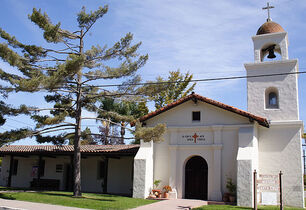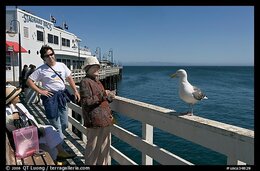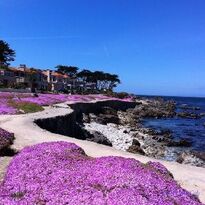Santa Cruz is still that kind of town. It is home to the only Beach Boardwalk on the West Coast, constructed in 1907 and still going strong. The Boardwalk boasts forty different rides as well as eateries, arcade games and giftshops. The jewel in the Boardwalk’s crown is the Giant Dipper Wooden Roller Coaster, built in 1924. This red and white marvel reaches 69 feet in height and can zip along at a dizzying 55 miles an hour, turning, twisting and dropping over the beach with stunning views of the harbor and the sea. For those who prefer a calmer ride, the lovely 1911 Looff Carousel shares National Historic Landmark status with the Giant Dipper. Hand carved by Charles Looff, one of the greatest carousel carvers of all time, this beautiful work of art also houses three historic band organs, a Ruth & Sohn and two Wurlitzers, one of which was brought over from Playland in San Francisco.
If surfing is your passion, Cowell Beach, just west of the Santa Cruz Municipal Wharf Pier, is a surfing Mecca, home to world-class surfers and beginners who want to learn the basics. Cowell beach has beautiful views, convenient parking and plenty of surf shops where visitors can arrange for lessons and rent boards, wetsuits and all the other surfer equipment anyone might need. For surfers or indeed any visitors to Santa Cruz who might enjoy a little luxury, the magnificently restored West Cliff Inn (174 West Cliff Drive, Santa Cruz,) sits on a bluff with breathtaking views of Cowell Beach and the Boardwalk. This exquisite Victorian mansion, now a Four Sisters property, offers every comfort, including tastefully appointed rooms, an elegant breakfast buffet and afternoon wine and hors d’oeuvres.
Nearby Henry Cowell Redwoods State Park, named for the same local industrialist for whom the beach is named, is a paradise for naturalists who enjoy hiking, fishing, camping and birdwatching. The park is also home to a large stand of old growth virgin redwoods, easily visible from the walking trail. These rare, ancient and magnificent Redwood trees, scientifically named Sequoia sempervirens, grow only in a narrow coastal strip from the corner of southwestern Oregon to 150 miles south of San Francisco. Henry Cowell Park is one of the best places to experience these awe-inspiring and timeless living beings. The largest trees in the park are 285 feet tall and sixteen feet wide. Scientists estimate the age of the oldest of these trees to be 1,400 to 1,800 years. No one should ever visit California without seeing the redwood trees. They live nowhere else on earth.

The land on which the park is now located, purchased in 1865 by Henry Cowell, was a former Mexican Hacienda, Rancho Canada del Rincon in el Rio San Lorenzo. As a historical reminder, California was a Spanish colony from 1769 to 1821, then belonged to Mexico from 1821-1848. The San Lorenzo River, referenced in the name of the hacienda, received its name in 1769 from Gaspar de Portola, leader of the first European land expedition to Alta (Northern) California. It was on this expedition that Portola claimed California as a Spanish colony.
The San Lorenzo River is a twenty-nine-mile long waterway originating in the Santa Cruz mountains and flowing south through Henry Cowell Park and the city of Santa Cruz, emptying into Monterey Bay and the Pacific Ocean. The first Mission Santa Cruz was established near the San Lorenzo River in 1791 by Fr. Fermin de Lasuen, a Franciscan missionary priest. Sadly, the first two log mission churches were washed away by flood waters, and finally a permanent adobe and rock mission was built on higher ground in an area now called Mission Hill in the center of Santa Cruz.
The Mission Hill neighborhood is well worth a visit. Although the adobe mission fell into disrepair in the 1830s, the bell tower collapsed in 1840, and the entire mission church structure succumbed to earthquakes in 1857, construction of a new church, on the site of the old mission, and re-named Holy Cross (the English equivalent of Santa Cruz,) began in 1858. After various renovations, this church survives today as the beautiful pastel Holy Cross Church on High Street in Santa Cruz. A lovely granite memorial archway, still in excellent condition, was erected as an entrance gate in 1891 to celebrate the centennial of the original mission.
In 1931, a half-sized replica of the original mission church was constructed nearby at Emmett and School Streets. Some of the original furnishings of Mission Santa Cruz were incorporated into this replica. This small church is now a chapel used by Holy Cross, which is still an active parish. Plaza Park survives today on the site of the original plaza surrounding the Mission, and visitors are welcome at Santa Cruz Mission State Historic Park, housed in the only surviving mission building, a former dormitory for native acolytes.
Although areas of downtown Santa Cruz were severely damaged by the Loma Prieta earthquake of 1989, the city has bounced back and become a destination for food lovers who appreciate the international and multi-cultural vibe. Two venerable Santa Cruz restaurants that remain ever-popular with the beach and party crowd are Stagnaro’s and the Crow’s Nest. Both are two story restaurants that offer glorious views of the ocean, the beach and the harbor. And both serve good quality American food with a strong Italian accent and plenty of well-prepared fresh seafood.
Stagnaro’s was founded in 1937 by Giovanni Stagnaro, whose father, Matteo, immigrated from Genoa through Ellis Island and on to Santa Cruz. The climate and seaside terrain around Santa Cruz are similar to the areas surrounding Genoa, where fish and seafood form the primary components of the local cuisine. Stagnaro’s was originally a small seafood market located at 59 Municipal Wharf. While the address has not changed, Stagnaro’s has evolved into the largest fish market in Northern California and a busy restaurant that serves all the old familiar favorites, including Louie and Caesar Salads, Crab Melt Sandwiches, Cioppino, Crispy Calamari and Seafood Lasagna. Loyal customers still love the Clam Chowder at Stagnaro’s, and nine members of the Stagnaro clan still work at this popular old family -run restaurant.



As in France and Japan, California’s small towns have maintained their historic integrity and culinary authenticity. Santa Cruz, once Spanish, once Mexican and now Californian, has a quirky identity all its own and has never succumbed to corporate food or mass culture. How fortunate I have been that a little bit of Santa Cruz has helped shape the person I have become. Wherever your home may be, you can live the California dream through our California Tea in the World of Tea Parties chapter in the Tea Book section of this website. Our California menu features the abundant seafood, fruits and vegetables that are fished and harvested in the fertile coastal farmlands surrounding Santa Cruz.









 RSS Feed
RSS Feed